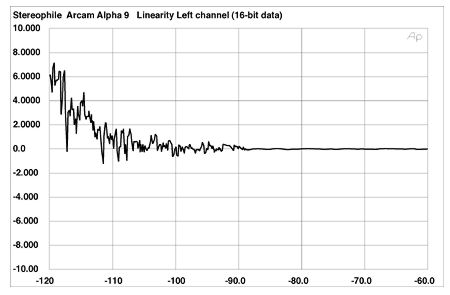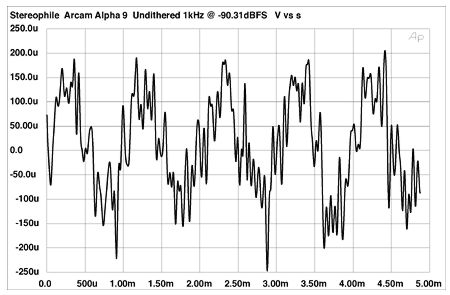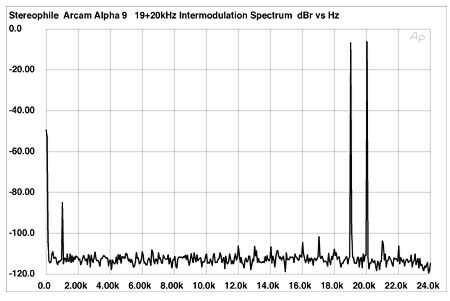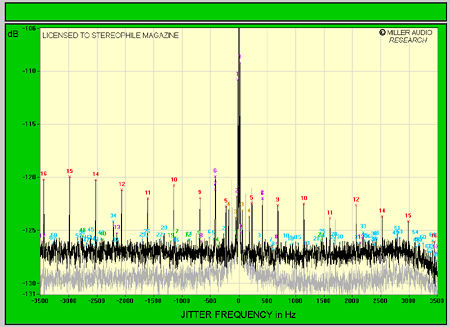| Columns Retired Columns & Blogs |
Arcam Alpha 9 CD player Measurements
Sidebar 4: Measurements
The Arcam Alpha 9's maximum output was 2.36V at 1kHz, some 1.45dB higher than the standard CD level of 2V. This was sourced from a low impedance of 47 ohms across the audio band, with positive (noninverting) absolute polarity. The error correction was excellent, the Alpha 9 playing without a problem through the Pierre Verany Test CD's track 32, which has a 1mm gap in its data.
The Arcam's frequency response was ruler-flat, as was its de-emphasis error, so I have not shown them. Its crosstalk was below -90dB in both directions below 2kHz, and was still below -80dB at 20kHz.
Fig.1 shows the spectrum of the Alpha 9's output while it reproduced data representing a dithered 1kHz tone at -90.31dBFS. The traces are free from harmonic distortion and high-frequency spuriae, but power-supply-related peaks can be seen at 60Hz and 180Hz. These are admittedly at a very low level, but given my druthers, I would have rather not seen them. They also make their presence known in fig.2, which extends the measurement bandwidth to 200kHz, with the player now decoding "digital black." The rise in noise floor with frequency is smooth and "white," without any evidence of aggressive noise-shaping.

Fig.1 Arcam Alpha 9, spectrum of dithered 1kHz tone at -90.31dBFS, with noise and spuriae, 16-bit data (right channel dashed).

Fig.2 Arcam Alpha 9, spectrum of digital silence with noise and spuriae, 16-bit data (1/3-octave analysis, right channel dashed).
The left channel's departure from perfect linearity, plotted against frequency, is shown in fig.3. Any level error is negligible down to below -100dBFS, and below ±2dB to around -112dBFS, which is superb performance. The Arcam's reproduction of an undithered 1kHz sinewave at -90.31dBFS, which is defined by just three voltage levels, was a little noisier than is usually found, however (fig.4).

Fig.3 Arcam Alpha 9, left-channel departure from linearity (2dB/vertical div., right channel dashed).

Fig.4 Arcam Alpha 9, waveform of undithered 1kHz sinewave at -90.31dBFS (16-bit data).
With respect to distortion, fig.5 shows the spectrum of the Alpha 9's output while it played back a 61Hz tone at full level. The only significant harmonic present is the second, at 122Hz. This lies 80dB down, however (0.01%). The high-frequency intermodulation spectrum (fig.6) was similarly clean, with the 1kHz difference component lying at -83dB (0.007%).

Fig.5 Arcam Alpha 9, spectrum, DC-1kHz, 61Hz at 0dBFS, 100k ohms load (linear frequency scale, 20dB/vertical div.).

Fig.6 Arcam Alpha 9, HF intermodulation spectrum, DC-24kHz, 19+20kHz at 0dBFS, 100k ohms load (linear frequency scale, 20dB/vertical div.).
Finally, using the Miller Audio Research analyzer (based on a National Instruments DSP PC card) to assess the Arcam Alpha 9's jitter performance gave the high-resolution spectrum shown in fig.7. The absolute level was 249.3 picoseconds, which is pretty good. The main jitter components were pairs of low-frequency sidebands at ±19Hz, ±38Hz, and ±413Hz (indicated with purple markers "1," "2," and "6"; I have no idea what these are due to), and data-related jitter components (red "5"). There are also hum-related jitter sidebands evident at ±60Hz (brown "3" and "4"). The noise floor is also a little higher than the best I have measured—the grayed-out trace in fig.7 is the jitter spectrum, taken under identical conditions, of the twice-as-expensive Meridian 508.24. The clock error was a low 41ppm.

Fig.7 Arcam Alpha 9, high-resolution jitter spectrum of analog output signal. (11kHz at -6dBFS with LSB toggled at 229Hz.) Center frequency of trace, 11kHz; frequency range, ±3.5kHz. (Grayed-out trace is Meridian 508.24.)
Summing up, these measurements indicate a well-engineered, thoroughly modern CD player.—John Atkinson
- Log in or register to post comments



































